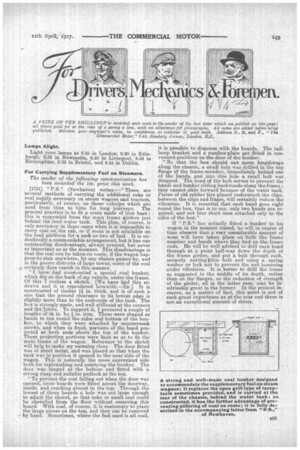A P1312 E OF TEN SHILLINGS is awarded each week
Page 21

If you've noticed an error in this article please click here to report it so we can fix it.
to the sender of the best letter which we publish on this page; all others paid for at the rate of a penny a line, with an allowance for photographs. All notes are edited before being published. Mention your employer's name, in, confidence, as evidence of good faith. Address D., M. and F., "A he Cconmercial Motor," 7-15, Itosebery Avenue, London, E.G.
Lamps Alight.
Light your lamps at 8.25 in London, 9.20 in Edinburgh, 8.38 in Newcastle, 8.40 in Liverpool, 8.34 in Birmingham, 8.35 in Bristol, and 9.24 in Dublin.
For Carrying Supplementary Fuel on Steamers.
The sender of the following communication has been awarded the los. prize this week.
[1731] " P.S." (Newhaven) writes :—" There are several methods of carrying the additional coke or coal supply ,necessary on steam wagons and tractors, particularly, of course, on those vehicles which are used from time to time for long journeys. The general practice is to fit a crate made of iron bars ; this is suspended from the main frame girders just behind the feed water tank. This plan, of course, is only necessary in those cases when it iS impossible to carry coal on the cab, or if room is not available on the load platform for a sack or two of fuel. It is undoubtedly a commendable arrangement, but it has one outstanding disadvantage, always present, but never
• so important as at the moment. This disadvantage is that the, coal can be taken en route, if the wagon happens to stop anywhere, by any chance passer-by, and in the poorer districts of large towns, some of the coal
4certainly does vanish in this manner.
"I have had constructed a special coal bunker, which fits on the back of my vehicle, under the frame. Of this I enclose a sketch. [We have had this redrawn and it is reproduced heDewith.—ED.]. It is constructed of timber 1i in. thick, and is of such a
• size that the ground clearance to its lowest edge is slightly more than to the underside of the tank, The box is strongly made, and well stiffened at the corners , and the loints. To support it, I procured a, couple of , lengths of 24 in. by in. iron. These were shaped as • bands to run round the sides and bottom of the bunker, to which they were attached by countersunk screws, and when so fixed, portions of the band projected at both ends above the top of the bunker. These projecting portions were bent so as to fit the main frame of the wagon. Reference to the sketch will help to make my meaning clear. The door fitted was of sheet metal, and was placed so that when the tank was in position it opened to the near side of the wagon. This is naturally the more convenient side both for replenishing and emptying the bunker. The door was hinged at the bottom and fitted with a. strong clasp and suitable padlock at the top.
"To prevent the coal falling out when the door was opened, loose boards were fitted across the doorway, inside, and reaching almost to the top. Through the lowest of these boards a hole was cut large enough to admit the shovel, so that coke or small coal could be shovelled from the floor without removing this board. With coal, of course, it is Customary to place the large pieces on the top, and they can be removed by hand. Sometimes, where the fuel used is all coal,
it is possible to dispense with the boards. The taillamp bracket and a number-plate are fitted in convenient positions on the door of the bunker.
"So that the box .should .not move lengthways along the chassis, a small hole was drilled in the top flange of the frame-member, immediately behind one of the bands, And into this hole a small bolt was dropped. The head. of the bolt serves to prevent the bands and bunker sliding backwards alosig the.frtuoae : they cannot slide forward because of the water tank. Pieces of old rubber tire placed underneath the clips, between the clips and frame, will certainly reduce the vibration. It is essential that each band goes right round the box, that is to say, only two bands are required, and not four short ones attached only to the sides of the box."
If " P.S." has actually fitted a bunker to his wagon in the manner stated, he will in course of time observe that a very considerable amount of wear will have taken Place on both the frame member and bands where they bed on the frame ends. Be will be well advised to drill each band through at a point half-way down the depth of the frame girder, and put a bolt through each, securely nutting 'this boltand using a spring washer or lock nut to prevent the nut loosening under vibration._ It is better to drill the frame as suggested in the middle of its depth, rather than on the flanges, as the reduction of strength of the girder, nil in the latter case_, may, be inadvisably great in the former. In the present instance, as a matter of fact, this point is not of such great importance as at the rear end there is not an exceptional amount of stress.






















